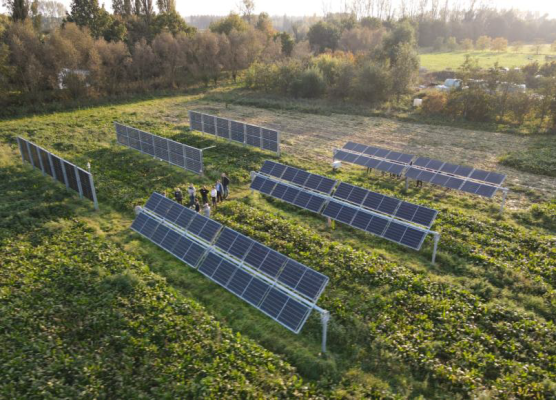Project summary
The expansion of renewable energies aims at meeting the energy demand of the EU while replacing fossil fuels, but it requires large areas of land. At the same time, food security is threatened by the impacts of climate change and a growing world population. Agrophotovoltaics (APV) can mitigate the conflicting interests between agriculture and open space photovoltaic systems for viable land, as it allows to produce energy and food at the same time on the same place through a combination of farming and solar generation with a total land use efficiency of up to 186%. This is why the EAGER project aims at improving policies to ease APV in Europe. It will enable the definition and set-up of favourable policy framework conditions for implementing APV as a praxis-oriented concept for achieving Greener Europe.
By generating a common understanding of suitable APV settings and contexts, identifying, analysing and transferring good practices, changing behaviour among policy actors of the participating regions towards supporting and expanding APV in their regions, 9 policy instruments will be improved by 2027.The 14 partners and 3 associated policy responsible authorities, coming from Germany, Belgium, Lithuania, Italy, Spain, Bulgaria, Poland, Serbia, and Ukraine are committed to high quality and efficient exchange of experience and policy improvement, acknowledging that the topic of APV is multi-layered and complex. It considers the policy fields of energy, agriculture, spatial development and land use, with impacts on economic development, and has the potential to contribute to sustainability and energy security. Its novelty in the regions encourages out of the box thinking and an innovative interpretation of good practices in the broadest sense.
Who is involved?
Our partnership is characterized by a strong transnational character, covering nine European nations, ensuring a good geographical and cultural coverage.
1. University of Applied Sciences Landshut (DE), Lead partner
2. Agricultural and Agrifood Technological Center ITAGRA (ES)
3. Catholic University of Leuven (BE)
4. Municipality of Ruhstorf an der Rott (DE)
5. Municipality of Strelcha (BG)
6. National Paying Agency under the Ministry of Agriculture of the Republic of Lithuania (LT)
7. Nuovo Circondario Imolese (IT)
8. Palencia Provincial Council (ES)
9. Provincial Development Agency (POM) Flemish Brabant (BE)
10. Public Institution Lithuanian Innovation Centre (LT)
11. Regional Energy Agency of Pazardjik (BG)
12. Rzeszow Regional Development Agency (PL)
13. Municipality of Bačka Palanka (RS)
14. Institution "Zakarpattia Regional Development Agency" (UA)
EAGER video
What is agrophotovoltaics, and how these can contribute for synergies between farming and renewable energy projects? Check our EAGER video and subscribe to our newsletter for inspiring idea on these topics.
What will this project change
APV has the potential to open up new space that is urgently needed for the PV expansion. In 2020, the EU reached 136 GW of solar PV installed generation capacity, which delivered around 5% of total EU electricity. To reach the 2030 target for RES and the objectives of the REPowerEU plan, the EU will need to additionally install, on average, approximately 45 GW per year.
On the other hand, agricultural land covers almost 50% of the EU territory. APV will mitigate the conflicting interests between agriculture and open space PV systems for viable land. Under certain conditions, the agricultural use of land can be combined with solar generation in APV. Synergies can be established, whereby PV systems can contribute to crop protection and yield stabilisation, with agriculture remaining the primary use of the land area. Studies show that the combination of farming and solar power allows a total land use efficiency of up to 186%.

